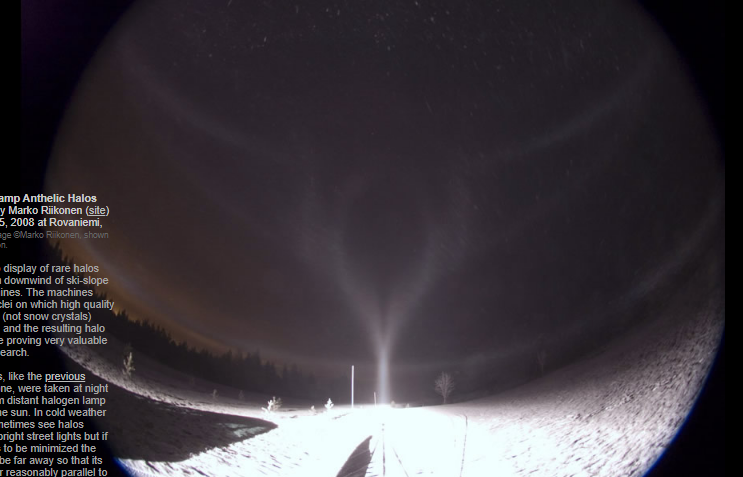Halos in a Bottle ~ Anthelic arcs
Halos in a Bottle: Unveiling the Enigmatic Anthelic Arcs
Atmospheric optics never ceases to amaze us with its intricate displays of natural phenomena. One such captivating sight is the presence of rare halos known as anthelic arcs. These elusive arcs are often observed in proximity to ski-slope snow machines, where high-quality ice crystals form on the nuclei provided by these machines. The resulting halo displays have proven to be invaluable for researchers studying atmospheric optics.
When capturing images of anthelic arcs, it is essential to replicate the conditions that occur during the formation of natural halos. Therefore, instead of photographing them in direct sunlight, these images were taken at night with a halogen lamp placed approximately 100 meters away, mimicking the position of the sun. In colder weather, it is possible to observe halos formed by bright street lights, but to minimize distortion, the lamp must be positioned far enough away so that its rays appear reasonably parallel to the swarm of ice crystals.
To understand the geometry of anthelic arcs, we need to define certain key points in the sky. Opposite the sun or lamp, and marked by the camera's shadow, is the subanthelic point. This point lies directly opposite to the source of light and serves as a reference for studying the anthelic point, which is located above it at the same altitude as the sun or lamp. The parhelic circle sweeps around the sky parallel to the horizon and exhibits variations in intensity along its path. This phenomenon can be observed both in photographs and through HaloSim ray tracing simulations.
One remarkable feature originating from the anthelic point is the presence of rare diffuse arcs that extend upward in a distinctive 'Y' shape. These arcs are formed through intricate ray paths involving multiple internal reflections in horizontal column crystals. Additionally, other uncommon column halos, such as the Tricker and Wegener arcs, can also be observed in conjunction with the diffuse arcs.
In close proximity to the anthelic point, we encounter the Tricker arcs, which touch the subhelic arc. The subhelic arc is formed by horizontal columns and Parry-oriented crystals. On the other hand, the subanthelic and helic arcs are primarily generated by Parry crystals alone. These captivating displays are also visible when facing the lamp.
While natural displays of these arcs are rare outside of Antarctica, the lamp view provides a glimpse into their exquisite beauty. Comparing the images captured with the halogen lamp to those taken in the South Pole showcases the similarities and nuances of these atmospheric phenomena.
The study of halos, including anthelic arcs, continues to intrigue researchers and enthusiasts alike. These captivating displays serve as a reminder of the boundless wonders that nature has to offer. By unraveling the complexities behind atmospheric optics, we gain a deeper understanding of our world's mesmerizing visual spectacles.

Halogen Lamp Anthelic Halos produced by Marko Riikonen (site) November 5, 2008 at Rovaniemi, Finland. Image ©Marko Riikonen, shown with permission.
The superb display of rare halos was 1-2 km downwind of ski-slope snow machines. The machines provide nuclei on which high quality ice crystals (not snow crystals) slowly form and the resulting halo displays are proving very valuable for halo research.
The images, like the previous ‘sunward’ one, were taken at night with a 100m distant halogen lamp replacing the sun. In cold weather we can sometimes see halos formed by bright street lights but if distortion is to be minimized the lamp must be far away so that its rays appear reasonably parallel to the ice crystal swarm.
The camera is pointing away from the lamp. Two points help define this part of the sky. Exactly opposite the sun, or lamp, and marked by the camera shadow is the antisolar or subanthelic point. Above that and at the same altitude as the sun or lamp is the anthelic point.
Sweeping around the sky parallel to the horizon is the parhelic circle. Notice how the intensity alters along the circle in both the photograph and the HaloSim ray tracing simulation. The blue spots in the simulation and perhaps also showing faintly in the image are a real effect produced by a difference between blue and red light in angle of cessation of total internal reflection.
Rising from the anthelic point in a huge ‘Y’ are the rare diffuse arcs. Their formation is via complicated ray paths involving multiple internal reflections in horizontal column crystals. Other rare column halos are the Tricker and Wegener arcs.

Touching the Tricker arcs above the anthelic point is a subhelic arc made by horizontal columns and Parry oriented crystals. Parry crystals alone generated the subanthelic (antisolar) and helic arcs, the latter are also visible in the view facing the lamp.
In natural displays many of these arcs are rarely seen outside of Antarctica. Compare the lamp view with the exquisite South Pole display also photographed by Marko Riikonen.
Note: this article has been automatically converted from the old site and may not appear as intended. You can find the original article here.
Reference Atmospheric Optics
If you use any of the definitions, information, or data presented on Atmospheric Optics, please copy the link or reference below to properly credit us as the reference source. Thank you!
-
<a href="https://atoptics.co.uk/blog/halos-in-a-bottle-anthelic-arcs/">Halos in a Bottle ~ Anthelic arcs</a>
-
"Halos in a Bottle ~ Anthelic arcs". Atmospheric Optics. Accessed on November 22, 2024. https://atoptics.co.uk/blog/halos-in-a-bottle-anthelic-arcs/.
-
"Halos in a Bottle ~ Anthelic arcs". Atmospheric Optics, https://atoptics.co.uk/blog/halos-in-a-bottle-anthelic-arcs/. Accessed 22 November, 2024
-
Halos in a Bottle ~ Anthelic arcs. Atmospheric Optics. Retrieved from https://atoptics.co.uk/blog/halos-in-a-bottle-anthelic-arcs/.